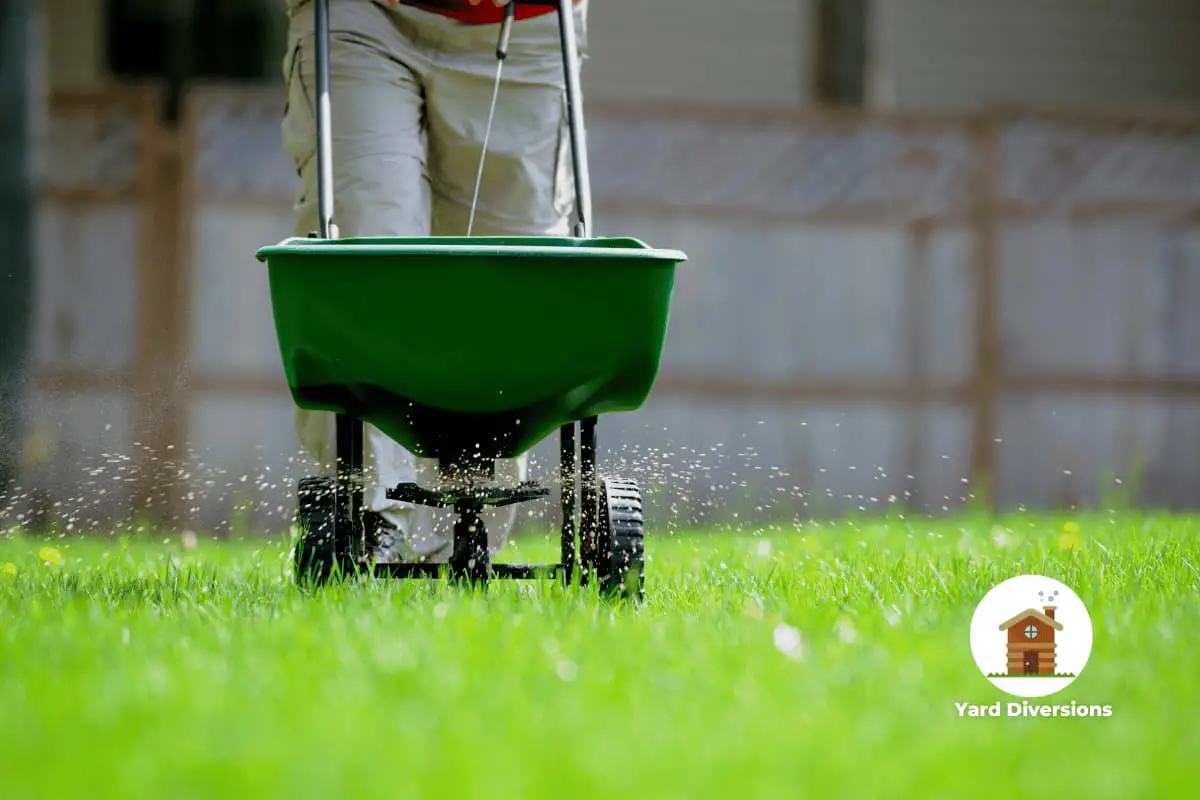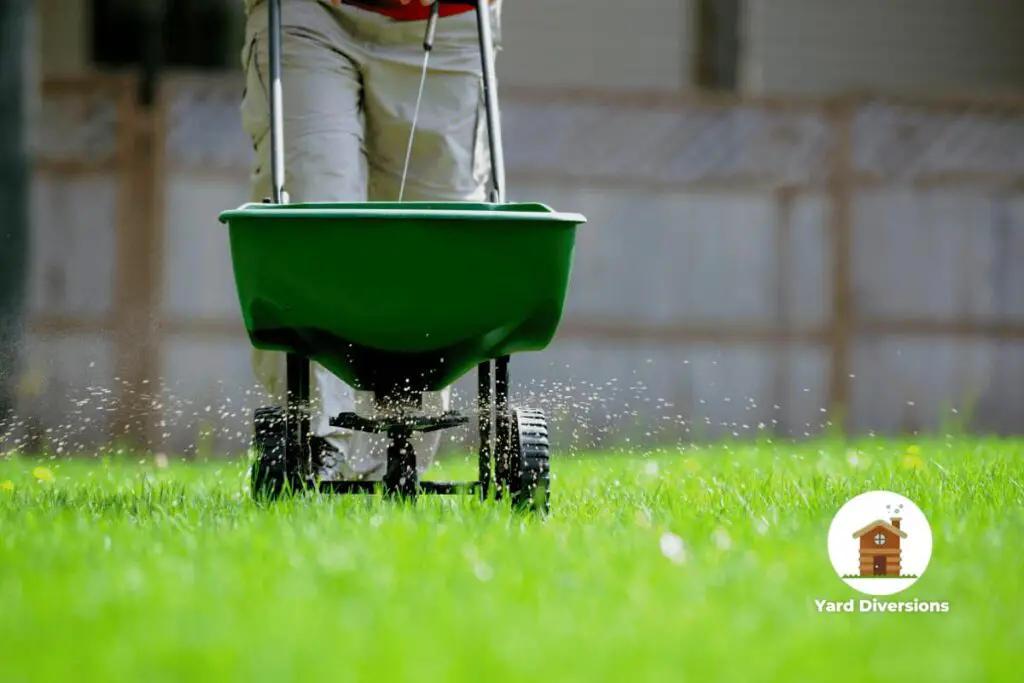If you’re looking for ways to keep your lawn healthy and green, you may wonder whether it’s necessary to fertilize after dethatching.
In this blog post, we’ll explore the pros and cons of fertilizing after dethatching, so you can decide how best to care for your lawn.

Should I Fertilize After Dethatching?
Dethatching your lawn is an important process in keeping your grass healthy and looking great.
It helps to eliminate the compacted thatch that builds up over time and can promote better water absorption and root growth.
But after dethatching, when should you fertilize your lawn? Is it necessary? This article will answer these questions and provide you with tips for properly fertilizing after dethatching.
Determining When You Should Fertilize After Dethatching
When it comes to fertilizing after dethatching, the most important thing to keep in mind is timing.
You should always wait until your lawn has “greened” up before applying fertilizer.
The type of grass you have and climate will determine the best season to dethatch and fertilize your lawn.
Ideally, you would dethatch, water, and fertilize your warm-season grass during the summer when it is actively growing.
After dethatching, rake up the newly exposed thatch and mow your lawn to help clean things up.
Fertilizing at this time is important because your grass has not been able to receive the nutrients and water it needs, and you need to help it recover.
If you are planning to apply pre-emergence herbicides (Like the Barricade below), do so after dethatching.
Different Types of Fertilizers to Use After Dethatching
After dethatching your lawn, you will want to fertilize it to promote growth and health. Different types of fertilizers can be used for different purposes.
Organic fertilizers, such as Milorganite® below, are great for replenishing soil nutrients. They are slow-release and provide a steady supply of nitrogen, phosphorus, and potassium.
Synthetic fertilizers are a more traditional choice. They are typically fast-acting and provide a quick dose of nutrients for the lawn.
Organic-synthetic blends are a combination of both organic and synthetic fertilizers and provide the benefits of both types.
They are designed to provide quick results while also providing long-term nutrition.
It is important to select the right type of fertilizer for your lawn’s needs. Be sure to read the label carefully and follow the instructions when applying fertilizer to your lawn after dethatching.
Understanding the Benefits of Fertilizing After Dethatching
Fertilizing your lawn after dethatching is essential to ensure that your grass can recover from the process and stay healthy.
Fertilizing gives your grass the nutrients it needs to grow strong and healthy. It also helps to promote root growth, which helps the grass stay resilient against pests, diseases, and other environmental stresses.
Fertilizing also helps keep your lawn looking lush and green. This can help improve the overall aesthetic of your lawn, making it look great while also providing a healthy environment for your family and pets.
The Best Time to Fertilize After Dethatching
When it comes to fertilizing your lawn after dethatching, timing is key. The best time to fertilize after dethatching is when your lawn has recovered from the dethatching process and is actively growing.
This is usually 3-4 weeks after dethatching. It is important to wait until the grass has greened up before applying fertilizer.
Depending on the type of grass and climate, the best season to dethatch and fertilize can vary. It is best to dethatch, water, and fertilizer for warm-season grass during the summer months.
It should be done after dethatching if you plan to apply preemergence herbicides. Additionally, it would be best if you waited until the grass is in active growth before dethatching or adding fill.
You should fertilize Bermuda every 30 days during the growing season and water once a week when the grass needs it.
Fertilizing your lawn immediately after dethatching will help keep your grass in optimal condition.
Tips for Properly Applying Fertilizer After Dethatching
Applying fertilizer after dethatching is an important part of ensuring a healthy lawn. Here are some tips to help you properly apply fertilizer after dethatching:
- Make sure you use the correct type of fertilizer for your grass type. Different types of grass require different types of fertilizers.
- Apply the fertilizer evenly across your lawn. Don’t pile it up in one area, as it can cause an uneven growth pattern.
- Fertilize when the soil is already moist. This will help the fertilizer to absorb better into the soil and reach the roots of the grass.
- Spread the fertilizer in a fan-like pattern, avoiding thick concentrations in any spot.
- Water your lawn immediately after applying the fertilizer. This will help it absorb into the soil and reach the roots of the grass.
- Avoid using too much fertilizer, which can lead to an unhealthy lawn. Follow the instructions on the package for proper application amounts.
Common Mistakes When Applying Fertilizer After Dethatching
When applying fertilizer after dethatching, it is important to be aware of common mistakes.
First, don’t apply fertilizer too soon. Grass needs time to recover from the dethatching process, and applying fertilizer too soon can damage the lawn.
Second, apply the appropriate type of fertilizer for your lawn and climate. Different types of grass require different types of fertilizers, and climates require different fertilizers.
Finally, be sure to follow the instructions on the fertilizer label and don’t over-apply the fertilizer. Too much fertilizer can cause lawn damage and can pollute water systems.
By avoiding these common mistakes when applying fertilizer after dethatching, you can ensure that your lawn stays healthy and looks great.
Signs That You Need to Re-fertilize Your Lawn After Dethatching
After dethatching your lawn, it is important to maintain it properly. One way to do this is by fertilizing it.
This will help keep your lawn in optimal condition and ensure it stays lush and green. However, certain signs you need to look out for may indicate it is time to re-fertilize your lawn.
One of the most obvious signs that it is time to re-fertilize is if you notice a sudden change in the color of your grass.
If the grass begins to fade or become discolored, it could be a sign that the nutrients are no longer absorbed.
Another sign is if you notice patches of grass struggling to maintain health. If your lawn has become patchy or full of weeds, then this could also be a sign that you need to re-fertilize your lawn.
Additionally, if you notice a decrease in growth and lushness in your lawn, this could indicate that your grass needs more nutrients.
Re-fertilizing can help restore the health of your lawn and bring back its vibrancy.
To ensure you are correctly fertilizing your lawn, follow the directions on the fertilizer bag and use the correct amount for your particular grass type.
Additionally, it is important to watch the weather and wait for rain or irrigation cycles before fertilizing. This will help ensure that your fertilizer is
What Is the Best Time to Fertilize Your Lawn After Dethatching?
The best time to fertilize your lawn after dethatching for lawn health is in the fall. This is when grass roots are actively growing and the cooler temperatures are ideal for nutrient absorption. Applying a balanced fertilizer will help the grass recover from dethatching and promote lush, healthy growth.
Conclusion
When caring for your lawn, dethatching, and fertilizing are two critical steps.
Dethatching helps to remove excess thatch and debris that can stifle grass growth while fertilizing helps to replenish the nutrients in the soil.
When done together, dethatching and fertilizing can help keep your lawn looking healthy and green.
It is important to remember to wait until after dethatching to fertilize, as doing so immediately could damage the fertilizer or the thatch.
Additionally, it is crucial to choose the right fertilizer for your grass type and climate and to apply it at the right time.
Following these guidelines can help ensure that your lawn looks its best.




